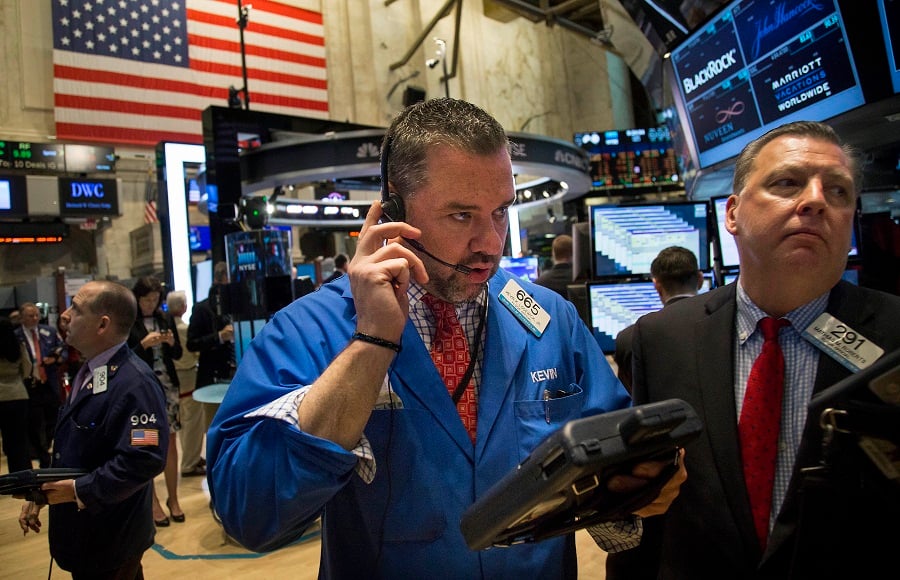Catalysts that drove the S&P 500's 12% summer tumble, from interest rate dread to a commodities rout and weak earnings, surfaced again. Strategists expect more downside.
You have to go back to August's selloff to find a week as bad as this one for U.S. equities.
Catalysts that drove the S&P 500 Index's 12% summer tumble, from interest rate dread to a commodities rout, surfaced again after being sidelined during October's surge. Signs of slowing growth from China to Europe rekindled concern that weakness could spread to America as the Federal Reserve prepares to tighten monetary policy.
While equities are nowhere near their August lows, the weekly slump raised concern that the S&P 500's six-week rally went too far, too fast. Volatility jumped after an October lull, with a measure of price swings surging 40%. Bank of America Corp. says shares are more likely to decline before New Year's amid weak consumer earnings and the specter of higher borrowing costs.
MORE DOWNSIDE THAN UPSIDE RISK
“For the next month and a half I think there may be more downside than upside risk to stocks,” Savita Subramanian, head of U.S. equity and quantitative strategy at Bank of America, said by phone. “The market is going to be more skittish about seeing the first Fed rate hike. We're not going to get there without a little more volatility.”
http://www.investmentnews.com/wp-content/uploads/assets/graphics src="/wp-content/uploads2015/11/CI1024961114.PNG"
The S&P 500 Index fell 3.6% in the five days, sliding below its average price for the past 100 days for the first time in three weeks. The decline snapped a run of six weekly gains, the longest rally of the year that included an 8.3% surge in October. The Chicago Board Options Exchange Volatility Index jumped above 20 for the first time since August, when it touched a four-year high.
For Ms. Subramanian, who in October lowered her year-end target for the S&P 500 to 2,000 from 2,100, the list of worries is tallying up. Weak corporate earnings and the prospect for higher rates will keep a lid on gains through the remainder of the year, she said in an interview with Bloomberg.
“Earnings are not coming in particularly great for sectors like consumer stocks, and on top of that you've got the Fed in December,” Ms. Subramanian, head of U.S. equity and quantitative strategy, said. “Those all kind of conspire against near-term gains.”
LOSS LEADERS
Consumer shares led declines in the period, as weaker-than-expected retail sales data and a welter of poor earnings reports in the industry added to concern that growth remains uneven. An S&P 500 index of 20 apparel makers and home builders plunged 7%, the most in more than four years.
Expectation the U.S. will raise interest rates in December boosted the dollar, cutting the appeal of raw materials at the same time that renewed signs of a slowdown in China and Europe damped demand expectations. That rekindled a rout in energy and materials shares, which had led gains during the October rally.
Energy producers sank 6% in the week as oil tumbled to a two-month low after U.S. crude stockpiles rose three times more than forecast. Chesapeake Energy Corp. plunged 17% as all but one of 40 companies in an S&P 500 index declined.
“We'll get to a point where we'll bottom out in the energy sector and we'll get some kind of new equilibrium for oil,” said John Stoltzfus, the New York-based chief market strategist at Oppenheimer & Co. “As companies move forward they tend to make adjustments that in the intermediate term can lessen their vulnerability to the dollar.”
5.5% GAIN
As of Nov. 11, the average year-end estimate of 21 equity strategists surveyed by Bloomberg put the S&P 500 at 2,135, implying a 5.5% gain to a level that would push the benchmark ahead of its May record and cap a fourth consecutive year of gains.
For Deutsche Bank AG, the index is only halfway through a rebound from its biggest slide in four years. London-based analysts at the bank, whose David Bianco has a year-end target of 2,050 for the index, said the S&P 500 has room to rally because the gauge's first correction in four years occurred outside of a recession.
Recoveries from such declines of 10% or more deliver three-month gains of 10% and six-month advances of 19%, Deutsche Bank strategists led by Greg Poole wrote in a Nov. 12 note. The S&P 500 ended the week 8.3% from its August low.
“The current rally is halfway through a typical recovery. We don't see a recession,” the strategists said.







